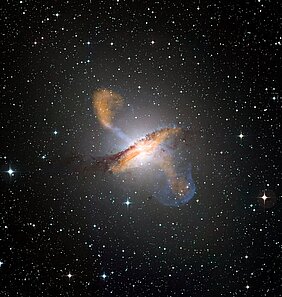Digitaler Einblick in die Galaxien und Supraleiter
| Datum: | 09.03.2022, 19:00 - 20:00 Uhr |
Alumnus Dr. Leonard Burtscher und Gastwissenschaftler Prof. Dr. John Deisz bieten einen Blick in die Welt der Galaxien und Supraleiter.

Am 9. März 2022 widmet sich der Digitale Einblick von 19 bis 20 Uhr einmal dem Blick in die Galaxien und Supraleiter. Für Laien verständlich erklärt werden die beiden Themen von den Referenten Dr. Leonard Burtscher und Professor John Deisz. In Kooperation mit dem SCIAS und dem Welcome Centre der Universität Würzburg wird der digitale Einblick diesmal in englischer Sprache durchgeführt. Bei Verständnisschwierigkeiten wird übersetzt.
Begrüßung Prof. Dr. Michael Erler, SCIAS
Alumnus Dr. Leonard Burtscher, Universität Leiden, 'Super-massive black holes and active galaxies'
Super-massive black holes slumber in the centre of galaxies. In most galaxies, it is hard to even notice them, but in some, so called "active galaxies" or "quasars", these black holes actively grow by ingesting matter, leading to a spectacular show that can be seen across the entire electromagnetic spectrum. The most surprising feature of this "show" is, however, that it likely influences the evolution of the entire galaxy, although it is approximately one hundred million times larger than the black hole in its centre.
Gastwissenschaftler Prof. Dr. John Deisz, California Lutheran University, 'Advancing Superconductor-Based Technologies through Computer Simulations'
Superconductors are strange materials that transmit electrical power over large distances with 100% efficiency. By comparison, a normal material carrying electricity does so imperfectly, generating wasteful heat along the way. The discovery of superconductors about 100 years ago has led to advances with important technologies such as medical imaging. In this presentation, I describe some of the exciting technologies, such as magnetic levitating trains and a greener, more sustainable electricity system, that will emerge when better superconducting materials are finally created. I conclude by describing the work being done in Würzburg and elsewhere to unlock the secrets to creating such materials.
Alle Interessierten sind herzlichen eingeladen, auf folgendem Zoom-Link teilzunehmen:
https://uni-wuerzburg.zoom.us/j/93155013786?pwd=UzNPeUYzdWdSLzNsR1Q0clJOWnV5dz09
Meeting-ID: 931 5501 3786
Passwort: 830955


